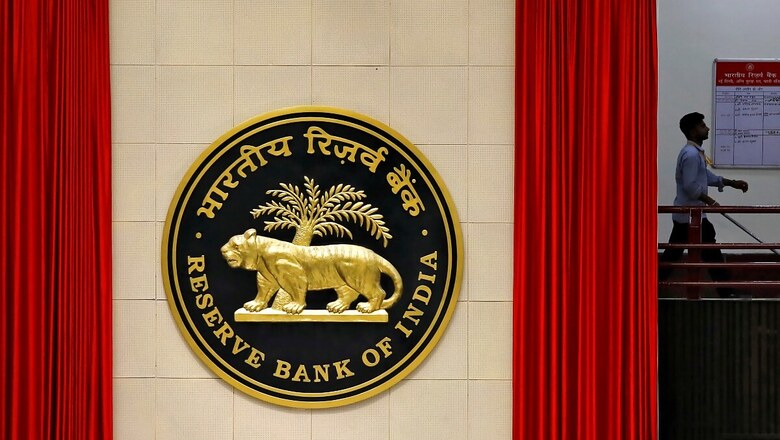
views
The steady increase in prices of food and non-food items has prompted the Reserve Bank of India (RBI) to hold lending rates this time, despite persistent concerns over GDP growth. This is the first pause by the RBI since the pandemic arrived in India and it is a prudent move, given the inflation scenario. The bank has already lowered lending rates by 115 basis points (1.15 per cent) since February this year and with this pause, the repo rate is still at a record low of 4 per cent.
A pause has been announced despite continued concerns on growth – the central bank has referred to negative GDP growth for this fiscal though it has not given any firm forecast as yet. But once again, the RBI has come forward to do the heavy lifting for kickstarting the economy by also announcing a one-time loan restructuring process for individuals, corporate and micro, small and medium enterprises (MSMEs).
The RBI alone cannot kickstart the economy – it can offer loans on easier terms, restructure existing loans to reduce repayment stress, push banks to lend more but it cannot stimulate demand. These, only fiscal measures can achieve. Unless the government comes up with another fiscal stimulus to push demand and handholds some stressed sectors, welcome measures from the RBI will not have the desired effect in either improving balance sheet stress of India Inc or in alleviating widespread income distress of individuals.
Why the RBI Monetary Policy Committee (MPC) was concerned about inflation becomes clear from the price graph of key vegetables. Data from the Department of Consumer Affairs show that retail prices of tomatoes, for example, rose by nearly seven times or by Rs 68 per kilo in West Bengal’s Purulia between June 1 and August 1. A kilo of tomatoes was selling for Rs 12 in Purulia but by August 1, the price had risen to Rs 80. The price of tomatoes has seen a huge spike in almost all mandis across the country. Ditto for some pulses and other kitchen staples.
While supply side issues – rains and flooding affecting crops and the distribution of vegetables is largely to blame for the continued worry on the food inflation front, non-food inflation has also remained elevated. Prices of petrol and diesel have steadily increase during this period (Delhi reduced VAT on diesel only recently, bringing down pump prices by nearly Rs 8 a litre) and contributed to overall inflation as logistics costs have risen in tandem. All in all, the concerns RBI has flagged on inflation in its bi-monthly monetary policy are valid and needed to be highlighted.
Governor Shaktikanta Das noted that the MPC was of the view that supply chain disruptions on account of Covid-19 persisted, with implications for both food and non-food prices. A more favourable food inflation outlook may emerge as the bumper rabi harvest eases prices of cereals, especially if open market sales and public distribution offtake are expanded on the back of significantly higher procurement.
“Nonetheless, upside risks to food prices remain. The abatement of price pressure in key vegetables is delayed and remains contingent upon normalisation of supplies. Protein-based food items could also emerge as a pressure point. Higher domestic taxes on petroleum products have resulted in elevated domestic pump prices and will impart broad-based cost push pressures going forward. Taking into consideration all these factors, the MPC expects headline inflation to remain elevated in Q2:2020-21, but likely to ease in H2:2020-21, aided by favourable base effects.”
According to analysts at ratings agency ICRA, the spike seen in veggies, fuel prices etc may moderate now but may not reflect in the inflation print if lockdowns continue in some states. “CPI (consumer prices index) inflation hardened in July, led by the spike in vegetable prices, elevated fuel prices and disruptions caused by localised lockdowns. Early data suggest that this uptick will reverse in August. However, with lockdowns getting extended in several states, the CPI inflation for the ongoing month may remain elevated, in a range of 5.5-6%. This may well result in another pause from the MPC (Monetary Policy Committee), in the next scheduled monetary policy review in October 2020.”
Das also gave a grim outlook for GDP growth. He said recovery of rural economy is expected to be robust due to progress in kharif sowing; manufacturing firms expect domestic demand to recover gradually from Q2. But consumer confidence turned more pessimistic in July.
“External demand is expected to remain anaemic under the weight of the global recession and contraction in global trade. Taking into consideration the above factors, real GDP growth in the first half of the year is estimated to remain in the contraction zone. For the year 2020-21 as a whole, real GDP growth is also estimated to be negative.”
Meanwhile, the RBI’s announcement on restructuring of personal and corporate loans - which were otherwise healthy but turned stressed due to the pandemic – is the big takeaway from the bi-monthly monetary policy this time. So loans taken by companies and individuals, which were being repaid on time before the pandemic but where the borrowers are now facing difficulties in meeting repayment timelines due to the pandemic, have been allowed this one-time window.
The RBI has laid down certain prudential norms for such loan restructuring and announced the setting up of an expert committee, headed by veteran banker K V Kamath, to lay down the terms of this loan restructuring process.
How will this ambitious loan restructuring scheme pan out? Can an individual alter terms of repayment of house or vehicle loan to align with her income, defer some EMIs? Will stressed sectors like real estate get a much needed breather on repayments? Will this scheme ease the pain for severely stressed sectors such as airlines and hospitality?
Analysts at ICICI Direct noted that the restructuring could mean:
1) Extension/rescheduling of residual loan tenure, with or without payment moratorium, for a period of not more than two years. Put simply, it could mean loan tenure could be extended even if there is no deferment of EMIs.
2) Conversion of interest accrued/to be accrued into another credit facility.
3) Conversion of debt into equity/other marketable/non-convertible debt securities etc. This may apply to companies.
In any case, such restructuring of personal loans will be a first in recent memory. And restructuring of corporate loans would be positive for banks in long run, especially public sector banks, as they have higher proportion of corporate assets.



















Comments
0 comment